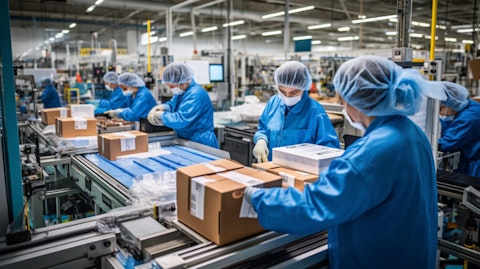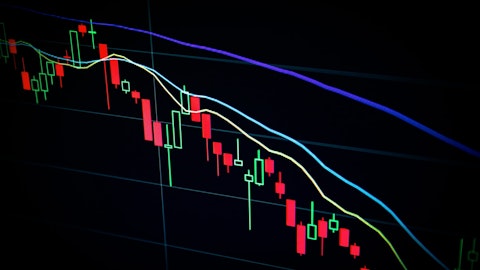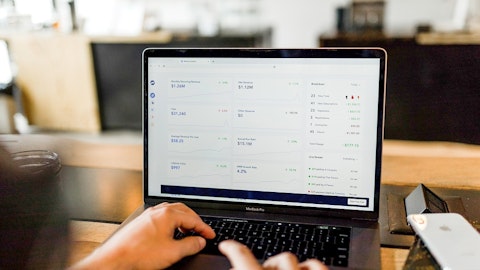Amcor plc (NYSE:AMCR) Q1 2024 Earnings Call Transcript October 31, 2023
Operator: Hello. And welcome to the Amcor First Quarter 2024 Results Conference. All lines have been placed on mute to prevent any background noise. After the speaker’s remarks, there will be a question-and-answer session. [Operator instructions] I’ll now turn the conference over to Tracey Whitehead, Head of Investor Relations. Please go ahead.
Tracey Whitehead: Thank you, operator, And thank you, everyone, for joining Amcor’s Fiscal ’24 first quarter earnings call. Joining today is Ron Delia, our Chief Executive Officer; and Michael Casamento, our Chief Financial Officer. Before I handing over, a few items to note. On our website, amcor.com, under the Investors section, you’ll find today’s press release and presentation, which we’ll discuss on this call. Please be aware that we’ll also discuss non-GAAP financial measures and related reconciliations can be found in the press release and the presentation. Remarks will also include forward-looking statements that are based on management’s current views and assumptions. The second slide in today’s presentation with several factors that could cause future results to be different than current estimates.

A factory line of workers working together to assemble protective packaging solutions.
Reference can be made to Amcor’s SEC filings, including our statements on Form 10-K and 10-Q for further details. Please note that during the question-and-answer session, we request that you limit yourself to a single question and one follow-up and then rejoin the queue if you have additional questions. With that, over to you, Ron.
Ron Delia: Thanks, Tracey, and thanks everyone for joining Michael and myself today to discuss Amcor’s first quarter results for fiscal 2024. We’ll begin with some prepared remarks before opening for Q&A. As seen on slide 3, Amcor continues to be an industry leader in safety with a recordable case frequency rate that has trended significantly downwards over many years. In our first quarter, 65% of our sites around the world were injury-free for the past 12 months, with more than 30% injury-free for three years or more. Safety is deeply embedded in Amcor’s culture, and providing a safe and healthy working environment is the number one focus for our global teams. Turning to our key messages on slide 4, first, we delivered a first quarter result in line with our expectations despite a challenging demand environment characterized by continued weak consumer demand and ongoing customer destocking.
Against this backdrop, our teams executed well and remained focused on managing the areas under their immediate control. Second, the first quarter performance puts us on track to deliver against our full-year guidance, which we are reaffirming today. Our expectations for phasing through the two halves of the fiscal year have not changed, and we continue to expect adjusted EPS for the second half of fiscal ‘24 to grow by mid-single digits over last year on a comparable constant currency basis. As a reminder, there are several reasons why we expect a stronger second half, including continued benefits and increased earnings leverage from ongoing price and cost actions, additional benefits from structural cost initiatives building through the year, a reduction in interest expense headwinds, and favorable comparisons to the prior year’s volume performance.
Our third key message is we’re making significant strides in our sustainability efforts within our own operations and in the design of our products. Our commitment to sustainability and the creation of a circular economy for packaging represents one of our most promising avenues for growth as we enable our customers to meet consumer demand for more responsible packaging. And fourth, we remain confident in our long-term growth and value creation strategy. The strength of our market positions and underlying business, our proven execution capabilities, and our consistent capital allocation framework collectively make a compelling case for investment in Amcor. Moving to slide five for a summary of our financial results. September quarter financial performance was in line with our expectations as we continued to take proactive cost and price actions to align the business with market dynamics, including ongoing inflation and continued weak and volatile volumes.
Sales were 6% lower than last year on a comparable constant currency basis, which reflects price mixed benefits of approximately 2% offset by an 8% decline in volumes, which was within the range we anticipated for the first half of fiscal ‘24. As expected, volume weakness persisted and was broad-based through the September quarter due to a combination of lower consumer demand and continued customer inventory destocking. Fiscal first quarter adjusted EBIT of $358 million was 5% lower than last year on a comparable constant currency basis. Benefits from ongoing cost actions and price and mix benefits were more than offset by the weaker volumes. And our teams drove working capital improvements which resulted in free cash flow being well ahead of the same period last year.
We expect to deliver strong cash returns to shareholders this fiscal year with returns of approximately $200 million in the first quarter, up more than 10% over last year through a combination of share repurchases and a growing dividend, which the board increased to $0.125 per share. I’ll turn it over now to Michael to provide some further color on the financials and our outlook.
Michael Casamento: Thanks, Ron, and hello, everyone. Turning to our flexible segment performance on slide 6, net sales were down 8% on a reported basis, which includes a favorable impact of 3% related to movements in foreign exchange rates and an unfavorable impact of 2% related to the pass through of lower raw material costs. On a comparable constant currency basis, net sales were down 6%, reflecting 8% lower volumes, partly offset by price mixed benefits of approximately 2%, as the business continues to take pricing actions to recover inflation. First quarter volume trends remain similar to last quarter with all regions continuing to be impacted by lower consumer demand and destocking. Volumes across North America and Europe were down high single digits with Europe a little softer than North America.
Volumes in Latin America were also down high single digits and in Asia volumes were broadly in line with last year as continued growth in India in a return to positive volume growth in China offset lower overall volumes in Southeast Asia. The impact of destocking across the flexible business was similar to last quarter, accounting for approximately one-third of total volume declines. By end market, we continue to see stock demand and destocking impact categories, including protein, coffee, liquid beverage and healthcare. Pet care and confectionary categories remain strong in key markets with volume growth delivered in the quarter. Adjusted EBIT was down 5%, incomparable constant currency terms for the quarter, reflecting favorable operating cost performance and price mixed benefits offset by the lower volumes.
Turning to Rigid Packaging on slide 7, reported sales were 6% lower than last year, including the favorable impact of 1% related to movements in foreign exchange rates and the unfavorable impact of 1% related to the path to a lower raw material cost. On a comparable constant currency basis, net sales were 6% lower than last year. As price mixed benefits of approximately 1% were offset by 7% declining volumes. In North America, volumes in both the beverage and specialty containers business continued to be impacted by lower consumer demand and similar levels of custom destocking as experienced last quarter. In the beverage business, overall volumes were down 9%, although mixed trends were favorable. In specialty containers, volume growth in food was offset by weaker volumes in health care and home and personal care.
In Latin America, while market demand was somewhat softer across the region, our business is benefiting from new business wins and overall volumes were up mid-single digits compared with last year. The businesses in Brazil and Colombia delivered strong volume growth, offsetting lower volumes in Mexico. Adjusted EBIT was 6% lower than last year on a comparable constant currency basis. Reflecting lower overall volumes partly offset by price mix benefits and favorable cost performance. In terms of cash flow and the balance sheet on slide 8, our adjusted free cash flow performance was in line with our expectations and meaningfully better than last year, enabling us to reaffirm our full year cash flow guidance, which I will come back to shortly.
The cash flow improvement of more than $170 million compared to the first quarter of fiscal 2023 mainly reflects our focus inventory reduction efforts, which have resulted in a decrease of more than $500 million since the peak in November 2022. We remain highly focused on working capital performance, which is particularly critical in this environment of continued inflation and rising interest rates. We also continue to return cash to shareholders, purchasing approximately 3 million shares during the first quarter for a total cost of $30 million. And consistent with our comments in August, we expect the allocated total of at least $70 million towards share repurchases in fiscal 2024. In terms of the balance sheet, we maintain a strong investment grade credit rating with leverage at 3.3 times, in line with our expectations at this time, taking into account the usual seasonality of cash flows and the short-term impacts of cycling the divestiture of our Russian business earnings and higher working capital levels.
We expect leverage will decrease to approximately 3x by the end of the fourth quarter. Turning to our outlook on slide 9, our Q1 performance was in line with our expectations, and we are reaffirming our full-year guidance for adjusted EPS of $0.67 to $0.71 per share. We continue to expect the underlying business to contribute organic earnings growth in the plus or minus low single-digit range, and share repurchases will result in a benefit of approximately 2%. The US dollar has strengthened slightly since August, and we now anticipate currency translation to result in a benefit of up to 2%. This is expected to be offset by a negative impact of approximately 3%, related to the sale of our three plants in Russia in December 2022. And we also expect a negative impact of approximately 6% from higher interest and tax expense.
Our expectations for interest and tax expense for the full year remain unchanged, with interest in the range of $320 million to $340 million and a tax rate in the range of 18% to 20%. In terms of cash flow, we are training better than the first quarter last year and we continue to expect significant adjusted free cash flow in the range of $850 million to $950 million in fiscal ‘24 representing growth of up to $100 million over last year. Our plan to repurchase at least $70 million of Amcor shares in 2024 is unchanged and we continue to pursue value creating M &A opportunities. Turning to slide 10, Amcor has a proven track record of strong and consistent long-term earnings growth. As noted on our call in August, it is important to call out that fiscal 2024 phasing of comparable earnings growth is not expected to align its prior years.
Consistent with our comments from last quarter, we anticipate challenging market dynamics will persist in the near term resulting in similar mid to high single digit volume declines through the December quarter. Combined with the unfavorable impact of higher interest expense, which is expected to moderate in the second half, our guidance for the first half is unchanged. Compared with last year, we expect that adjusted EPS for the six months of fiscal 2024 will be down in the high single digit to low double digit range on a comparable constant currency basis. For the second quarter, this implies adjusted EPS and EBIT in absolute terms will be broadly in line with or marginally lower than the September quarter just finished. As Ron mentioned earlier, our confidence in delivering mid-single digit comparable constant currency earnings growth in the second half of fiscal 2024 and resuming our long-term trend of high single digit earnings growth shortly thereafter is supported by visibility to several known second half factors.
First, we have the benefit of approximately $35 million from structural cost-saving initiatives that builds through the year. Second, we have increased earnings leverage resulting from ongoing benefits of price and cost actions taken. Third, as I noted earlier, a reduced interest headwind. And fourth, we expect that customer inventories will have largely normalized as we progress through the second half and we will benefit from favorable prior year volume comparatives. Finally, and also consistent with our comments in August, we do not need to see a significant change in the demand environment to return to solid earnings growth in the second half and beyond. So with that, I’ll turn the call back for Ron to provide some longer-term comments.
Ron Delia: Thanks, Michael. Before we open the call to questions, I want to provide a few words on the building blocks that inform how we think about growth over the longer term and then finish with a brief preview of our 2023 sustainability report, which will be released in the coming days. Looking at slide 11, we have multiple drivers that have enabled us to deliver solid and sustainable earnings growth over the longer term, including opportunities in priority categories, emerging markets, and through innovation. These have not changed and collectively give us confidence in our ability to deliver future growth in line with our historic trend rates. Turning to slide 12 and some highlights from our forthcoming sustainability report, which covers the significant strides we’ve made in product development and operational sustainability.
Sustainability provides meaningful opportunities to differentiate and drive growth and value. This is particularly important in today’s landscape as consumers focus on the critical need for more sustainable, high-performance packaging solutions, and as customers increasingly look to work closely with responsible, sustainability-focused partners. Starting with our own operations, since launching Amcor’s EnviroAction program 15 years ago, we’ve diligently worked towards reducing our greenhouse gas emission intensity and have achieved a cumulative reduction of more than 40% against our 2006 baseline. Along the way, we’ve also increased our ambition and committed to net zero emissions by 2050 in line with the science-based targets initiatives.
In fiscal 2023, we delivered an annual reduction in absolute emissions of 10% through a range of measures, including an increasing focus on the use of renewable electricity. In addition to carbon-related objectives, we maintain robust targets for reducing water and waste. 100% of our sites have a water management plan in place, and 143 of our sites have achieved zero waste to disposal certification, which is an increase of around 20% in the last 12 months. Transitioning to slide 13, we also continue to make significant progress in supporting the development of circular systems and what we believe are the three requirements for responsible packaging. Package design, waste management infrastructure, and consumer participation. Amcor’s industry-leading innovation capabilities position us well to develop the more sustainable and high-performing packaging consumers are looking for, and we believe this is one of our greatest opportunities for growth and differentiation.
Today, almost all of our rigid packaging and specialty carton portfolios are fully recyclable. Looking at our flexibles portfolio, 61% fiscal 2023 sales were recyclable ready, according to the Ellen MacArthur Foundation definition, meaning these solutions are designed to be recycled using current technologies where infrastructure is available. Additionally, another 28% of sales had recyclable-ready alternatives available, providing a meaningful growth opportunity when our customers are ready to transition more of their portfolios to sustainable solutions. In total, 89% of our flexible packaging portfolio is designed to be recycled or has a recycle-ready alternative, a six percentage point increase over fiscal 2022. Our use of recycled content also continues to grow, increasing by 29% over fiscal ‘22, reflecting our commitment to work closely with customers to reduce the use of virgin materials.
Over the past four years, we’ve more than tripled our use of recycled material, and we’re confident we’ll achieve 30% recycled content across our portfolio by 2030. We also continue to leverage our position as an industry leader and trusted resource to help our customers navigate their sustainability journeys. As an example, in fiscal ‘23, we hosted several Amcor webinars which were attended by hundreds of customers and covered topics such as the use of recycled content in food contact and healthcare packaging and the impact of evolving regional regulations on packaging options. Through these efforts, we’re reinforcing our value proposition and helping customers accelerate conversion of their packaging portfolios to comply with emerging regulations and to meet their own sustainability goals.
We take pride in the strides we’ve made across all aspects of our sustainability journey. We eagerly anticipate the opportunities ahead, which will continue to differentiate Amcor and also advance our growth objectives, all while contributing to the creation of a circular economy for the packaging industry. In summary on slide 14, fiscal ‘24 has started in line with our expectations. We have reaffirmed our earnings and cash flow guidance today as we continue to have confidence and visibility to solid earnings growth in the second half. We’re making good progress on our sustainability agenda, and we remain focused on our strategy to deliver long-term growth and value creation. Operator, we are now ready to open the call for questions.
Operator: Your first question comes from the line of Ghansham Panjabi with Baird.
See also 16 Biggest Lab Grown Meat Companies in 2023 and 20 States That Produce Most Wind Energy.
Q&A Session
Follow Amcor Plc (NYSE:AMCR)
Follow Amcor Plc (NYSE:AMCR)
Ghansham Panjabi: Thanks, operator. Good day, everybody. Ron, could you give us a bit of a sense as to what your base case is for volumes for fiscal year ‘24? And I’m just trying to get a sense as to the sequencing beyond the first quarter, which was down 8%. Would it be sort of 4Q before you hit that inflection point on a year-over-year basis?
Ron Delia: Thanks for the question, Ghansham. Look, firstly, as we entered the year, we flagged that we expected volumes to be down mid-to-high single digits for the first half. And that’s exactly what we saw in the first quarter. And we expect similar trajectory for the second quarter as well. As we look forward to the second half, we do expect a trajectory to improve. So we would expect that the destocking will abate as we get past yearend and as we start to cycle several quarters of inventory reductions, we would expect that impact to start to moderate. And we would expect for the second half volumes more reasonably or flat to up to plus or minus low single digits. I think it’s more reasonable to expect that the trajectory will improve now exactly the rate at which that trajectory improves in the second half is difficult to predict.
But certainly as we get into the fourth quarter, the comps get a lot easier. And we would expect things to be improving as we exit the year.
Ghansham Panjabi: Okay, thanks for that, Ron. And I’m just trying to understand the divergence also between volumes which are quite a bit lower against improved price mix as you’ve established over the last couple of quarters and sustainability of that dynamic. And typically during periods of weaker volumes, there tends to be some sort of a trade-down and you actually are showcasing the opposite. So more color on that, please.
Ron Delia: Well, look, mix over a longer period of time over multiple years is a major source of earnings leverage for us and has been over a long period of time. As we emphasize higher value segments, both product segments and market categories, mix is a very important part of our playbook. For this year, on a full year basis, we expect mix to be more or less neutral. We’ve had a reasonably good start in the first quarter with positive mix in both segments. We would expect that probably will continue in the second quarter, but for the full year, we would expect that might normalize a little bit. The reason for that is some of the segments that are higher value have declined at a lower rate than some of the lower value categories.
But as we look forward into the second half, we think that the healthcare destocking will continue and ultimately that will balance out the positive first quarter. So all up relatively neutral for fiscal ‘24, but on a multi-year basis, mix is absolutely part of the earnings algorithm going forward.
Operator: Your next question comes from the line of Daniel Kang with CLSA.
Daniel Kang: Good morning, everyone. I guess the first question for me is on destocking cycle please, persist in the quarter. Are you seeing any evidence or signs of destocking easing as we walk into the second quarter? Perhaps you can comment on what you’re seeing on customer stock levels as well.
Ron Delia: Yes, look, I think we’re using the term destocking. I think what we’re seeing is more broadly is just inventory reductions. Destocking might imply that inventories started at a higher level. And I think that’s certainly true in some categories that were subject to more of the supply chain constraints and raw material shortages over the last 12 to 18 months. There certainly were some inventory accumulations, but I think we’ve got a few different dynamics that are driving the inventory reduction trend. The first is for those categories that started at a high level, obviously they’re working down the excess at a time when consumer demand has softened. And also carrying cost of inventory is now much higher than it’s been in a long period of time.
So I think that we’re seeing a number of companies including Amcor try to drive inventories down to lower levels than they’ve been in quite some time. I know that we are certainly on that path. So I don’t expect that trend to be beyond to be passed us in the second quarter, particularly as we’re heading towards a yearend and cash flow at yearend becomes an important metric that companies are driving towards. So we would expect that the destocking will abate in the second half but not in the second quarter.
Daniel Kang: Got it, thanks Ron. Secondly, I’m just interested in the progress of the new packaging products AmLite, AmFiber, et cetera. Realize it’s early days, but can you comment on the volume growth and customer adoption that you’re seeing and the pricing premium that you’re achieving?
Ron Delia: Yes, look, we’re really excited about some of those platform products that you mentioned, AmLite, which is a recyclable ready retortable structure, AmFiber, which is a paper based solution, AmSky, which eliminates PVC and PVDC from blister packaging. We think that we’ve got some really special products there with a really compelling value proposition for customers that are trying to drive their own sustainability agenda. It is early days. Several of those products though are generating real sales. So AmPrima which is also a recyclable-ready alternative, AmSky, AmFiber, they’re all each generating sales in the tens of millions of dollars, low tens of millions of dollars, but real meaningful sales. AmSky, it’s early days and it’s primarily oriented to the pharma industry, so the qualification period is a bit longer.
But we are in active trials with a whole range of customers on that one as well. So we continue to be really excited about those platforms that you’ve asked about.
Operator: Your next question comes from the line of Adam Samuelson with Goldman Sachs.
Adam Samuelson: Yes, thank you. Good afternoon. I was hoping maybe first talk about just the performance in the quarter from the difference between volume and comparable constant currency operating profit growth and this very little volume you leverage in the period and to contrast the fiscal ‘23 experience, maybe just Ron still more color kind of how are you able to now that gap and volumes on down, mid to high single digits, kind of keeping the profit declines that narrow.
Ron Delia: Got it. Look, it’s just been really aggressive pulling the cost lever really aggressively. And we continue to do that through the back end of fiscal ‘23 and into the start here in the first quarter of fiscal ‘24. So you might recall in August, we talked about the cost actions that we took in fiscal ‘23 where we reduced costs by over $200 million. We reduced headcount by over 1,200 people. We had pulled the procurement lever really hard. We cut overheads. All of that continued in the first quarter and actually accelerated. So in the first quarter coming off a year where we took $200 million of cost out, in the first quarter we took another $70 million of cost out versus the first quarter of the previous year. And so that’s really resulted in improved earnings leverage and much, I’d say a much more dynamic ability to flex costs in the face of weaker volumes.




